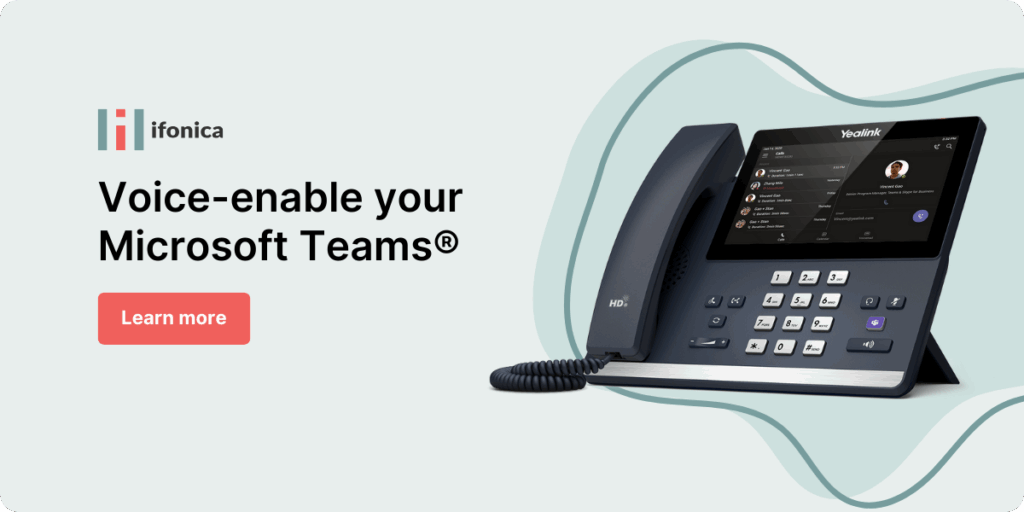UCaaS: The essential framework for business operations
Imagine you’re working on a project with a team that’s scattered across different locations. Working closely with colleagues, communicating with clients, and ensuring everyone is in agreement is crucial. That’s where Unified Communications as a Service (UCaaS) comes in—it’s like having a superpower that lets you bring everyone together, regardless of where they are. With UCaaS, you can make voice or video calls, send messages, and share files all from one place, making it easier to get work done and stay connected. It’s like having your own personal communication hub, where you can access all the tools you need to communicate and collaborate with others. UCaaS enables businesses to enhance their productivity and customer satisfaction, enabling them to remain competitive.

How UCaaS is transforming the modern-day workplace in 2025
1) AI-powered collaboration takes center stage
AI is quickly transforming how teams communicate and collaborate. It’s necessary for businesses to embrace and take advantage of these advancements to stay competitive. UCaaS platforms now provide real-time transcription alongside live translation functionality and automated meeting summaries with intelligent note-taking capabilities. Collaboration platforms like Microsoft Teams and Zoom now include AI copilots that automate tasks and generate content to provide valuable insights that only further enhance productivity.
2) Enabling seamless, hybrid work
The shift toward hybrid work models has transitioned from a temporary arrangement to a standard workplace practice. The delivery of consistent communication experiences depends on UCaaS platforms that support devices and locations both in office and remote settings. Smart meeting room integrations (with AI-driven cameras, presence sensors, and room analytics) are making meetings more inclusive, ensuring everyone has a seat at the virtual table.
3) Deep integration with business applications
UCaaS platforms seamlessly connect with essential business systems like CRMs and ERPs. This integration streamlines workflows, making sure teams stay connected to their daily tools without any hiccups. APIs and low-code/no-code solutions enable customized communication systems that seamlessly integrate with operational processes, avoiding the need for universal solutions.
4) A stronger emphasis on security and compliance
With the continued risk of cyber threats and the tightening of regulations, prioritizing security has become a crucial business requirement. Contemporary UCaaS solutions provide comprehensive end-to-end encryption, incorporate zero-trust architectures, and comply with HIPAA and GDPR frameworks as well as SOC 2 standards. Advanced threat detection systems powered by AI, along with user behavior analytics, empower solution providers to foresee vulnerabilities and safeguard communication confidentiality effectively.
5) UCaaS and CCaaS convergence
The distinction between staff communication and customer relationships continues to fade. A significant convergence has occurred between UCaaS and Contact Center as a Service (CCaaS), which allows frontline teams to collaborate better with back-office teams. A unified communication approach only further enhances customer experiences, reduces operational silos, and provides companies with faster support capabilities.
6) Mobile-first and BYOD support
The dispersed nature of teams combined with mobile workflows drives UCaaS providers to enhance mobile functionality. Through smartphones, users can access complete communication suites that include voice, video, and messaging capabilities. Businesses using BYOD policies with their security protocols achieve flexible and secure communication across any workplace environment.
7) Intelligent routing and presence awareness
Advanced presence detection and context-aware routing are streamlining communications. Modern UCaaS solutions now use real-time user conditions to direct communications through availability-based routing, workload analysis, and location detection. This system decreases response delays and minimizes disruptions while optimizing communication flow.
8) Driving sustainability and cost efficiency
Cloud-based UCaaS platforms eliminate the need for on-premise infrastructure, supporting ecological IT goals and reducing environmental impact. Businesses that use flexible pricing models such as pay-as-you-go options can efficiently scale their operations without increasing their operational expenses.
9) Enhanced analytics for smarter decisions
The analytics dashboards of current UCaaS platforms display detailed information about employee interactions and engagement statistics along with communication patterns. Business leaders use obtained communication data to make strategic decisions about policy implementation and digital well-being programs as well as employee training initiatives.
10) Focus on personalization and employee experience
Employee experience stands as an essential strategic focus for many companies. Modern UCaaS platforms integrate with experience platforms to provide users with customized alerts together with focus time recommendations, wellness check-ins, and other personalized features. The goal is to provide people with flexible communication options that help them manage their workload while optimizing their job satisfaction.
Looking ahead
The future of UCaaS is likely to be characterized by a greater emphasis on flexibility, integration, and adaptability to meet the ever-changing needs of a distributed workforce. The shift towards remote work has made it increasingly one of the most invaluable tools for businesses, with features like video conferencing, presence cues, and quiet hours becoming more important than ever. Businesses that want to future-proof their communication strategy should stay ahead of these trends when supporting either their global hybrid workforces or modernizing existing legacy systems.
If you are on the lookout for UCaaS platforms or want to keep your strategy up to date with the latest trends, then let’s chat.